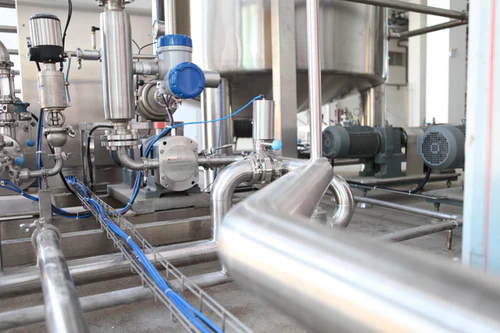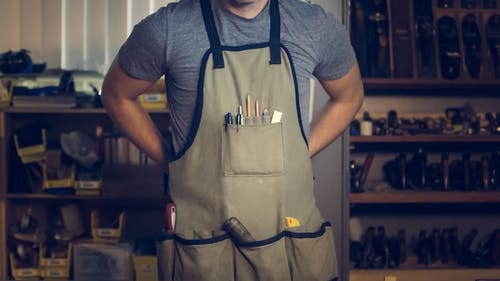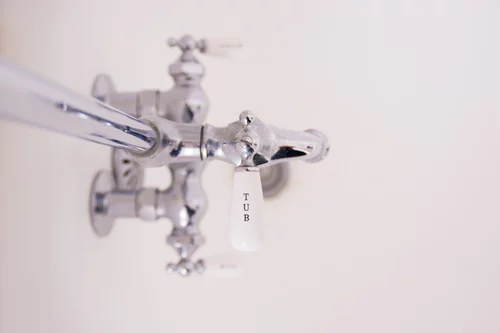Solder in Plumbing and Electrical Work
by Alan Penser
Affiliate Disclosure ...
THIS PAGE MAY CONTAIN AFFILIATE LINKS, MEANING WE RECEIVE A COMMISSION IF YOU DECIDE TO MAKE A PURCHASE VIA OUR LINKS, THERE IS NO COST TO YOU ... PLEASE READ OUR FULL DISCLOSURE FOR MORE INFO ... THANK YOU!
Posted on 02-03-2020 09:39 PM

The use of solder in plumbing and electrical work has been one of the great unsung inventions of modern times. Nobody thinks twice about the fact that the copper plumbing in their house, and also the working of every electrical piece of equipment, depends upon soldered joints and connections.
It should be given a grandstand position in any history of modern civilisation, but it is seldom, if ever mentioned.
Copper plumbing pipes are classically reliable and durable. They resist corrosion and work well in both cold and hot water environments, but without solder they wouldn't be able to hold water!
Read on and we will do or best to redress that lack of knowledge of such a fundamental industrial joint making technique.
What Is Solder Made Of
Solder is a fusible metal alloy that, when melted, functions to join two or more metals together in a process known as soldering. In plumbing systems, soldering produces bonds between copper pipe and fittings.
The connections produced by solder are liquid and gas tight. There are three types of soldering: soft soldering, silver soldering, and brazing. Each type differs in the strength of the metallic bond and the temperature required to melt the solder.
 Soft soldering requires the least amount of heat, but produces the weakest bond, while brazing produces the strongest bond at the highest temperatures.
Soft soldering requires the least amount of heat, but produces the weakest bond, while brazing produces the strongest bond at the highest temperatures.
Solder generally used in plumbing applications is soft solder and typically has a melting range between 190 and 840°f, although alloys with melting points between 360 and 370°f are the most commonly used.
Solder is available in a variety of compositions, and it is the relative percentages of the metallic components which determine the melting point of the solder.
Solder Flux
In metallurgy, a flux (derived from Latin fluxus meaning "flow") is a chemical cleaning agent, flowing agent, or purifying agent. Fluxes may have more than one function at a time.
They are used in both extractive metallurgy and metal joining. Some of the earliest known fluxes were carbonate of soda, potash, charcoal, coke, borax, lime, lead sulfide and certain minerals containing phosphorus. Iron ore was also used as a flux in the smelting of copper.
These agents served various functions, the simplest being a reducing agent, which prevented oxides from forming on the surface of the molten metal, while others absorbed impurities into the slag, which could be scraped off the molten metal.
As cleaning agents, fluxes facilitate soldering, brazing, and welding by removing oxidation from the metals to be joined. Common fluxes are: ammonium chloride or rosin for soldering copper and tin; hydrochloric acid and zinc chloride for soldering galvanized iron (and other zinc surfaces); and borax for brazing, braze-welding ferrous metals, and forge welding.
Types of Soldering
Systems are assembled using many types of joints ranging from compression fittings, copper tube, iron/ metal, and plastics. However, copper tube is the principal plumbing material which is jointed using soldering techniques.
Some background about brazing and soldering there are three main concerns when considering whether a brazed or soldered joint is coatable:
- will the joint physically survive the heat exposure of the process?
- will the solder/braze material contaminate other parts?
- will the joint area meet customer quality requirements for appearance and performance.
Soldering is the practice of using solder, a filler, to join pieces of metal together at a fairly low temperature. The solder heats to a liquid and creates a bond between two metal materials to create an electrically conductive joint. Although soldering can seem a little intimidating the first time, rest assured after some practice you'll see how easy it is. The tip is an attachment to the iron and the main tool in soldering. Tip width matters depending on the size of the solder pad you are working with. There are many different types of tips out there to use with different projects.
The following types of tips are usually preferred because they offer more contact:
- conical,
- pointed,
- screwdriver and
- chisel.
 Not maintaining a clean and well tinned tip with a coat of solder at all times could lead to a soldering nightmare. Tinning your tip will improve conductivity and add longevity to your tip by reducing oxidation.
Not maintaining a clean and well tinned tip with a coat of solder at all times could lead to a soldering nightmare. Tinning your tip will improve conductivity and add longevity to your tip by reducing oxidation.
Always keep a damp sponge or metal wool cleaner nearby to ensure you are always working with a clean tip. If you do use a damp sponge, wipe the tip quickly so as not to cool off the tip too much.
Using a metal wool cleaner doesn't require water, so no heat will be lost.
Electrical and Plumbing Soldering
Soldering, and its higher temperature cousin, brazing, are one of essentially two ways create metal-to-metal bonds, and they allow the use of low-temperature techniques that still create relatively stable bonds between two metal surfaces.
Soldering is also an interesting chapter in the field of metallurgy, on account of it being based around so-called intermetallic compounds (imcs). Welding stands in contrast to soldering, where high temperatures melt the metal on both sides of the pieces that are being joined, permanently fusing them.
Welding is a high-strength, high-reliability way of joining metal pieces, but is unfortunately wholly unsuited for delicate electronics where excess heat can damage parts and the goal is more to ‘glue’ electrically conducting elements together than to melt them together.
This also leads us to the reason why soldering and imcs are such a source of trouble, to the point where imcs are referred to as ‘evil’. Imcs are essentially bits of the two metal surfaces on either side dissolved into the solder, causing enough of a joining that each side of the joint is more or less stably fused with the solder.
Unfortunately such an imc is a far cry from the stable solid metal of a welding joint, and as a result can be brittle depending on exactly which metals were involved in the solder alloy. But the imcs formed in soldering are strong enough, and their formation is at the root of why every solder alloy uses tin.
Tin has the property that it is very good at letting other metals dissolve into it. In fact, it’s possible to solder with pure tin, although most solder is improved by adding other metals into the mix.
Soldering Iron
A soldering iron presents a sufficiently high temperature to melt the solder, which usually links two regions of circuitry merchandise. Heat is established merely by an electric current which moves through a resistive heating system component.
Utilized explicitly by electronics restoration specialists to correct computer gaming systems and tv sets, solder irons have grown to be a standard hand tool in any diy toolset. El
The welding metal referred to as solder frequently includes a mixture of tin and lead, nevertheless may also be a variety of alloys.
Soldering is also are available in many varieties, which supplies alternatives for tasks that need a more powerful connection.
The uise of a soldering iron is perfect for consumer electronic repair collectively.
Soldering may be used to generate a connection with no possibility of eliminating both attaching components in operation. With regards to consumer electronics, its a system for technicians to produce conductive associations among fragile cables or perhaps circuit panels.
Plumbing Solder
A bewildering list of solders is available for the uses of solder. Across the reange thse include body solders, lead-base, lead-free solders, low melting solders, miter-al-braze (mab), tin-antimony solders, tin-base, tin-cadmium solders, tin-lead solders, and tin-zinc solders.
A range of high, medium, and low temperature soldering alloys to meet a variety of different needs is sold. Applications: for these are in plumbing, and also in electronics, plating, and HVAC.
Lead Free Solder vs Lead Solder
The main difference between lead-free and tin-lead solders, from the application of soldering techniques to desoldering, repair and rework point of view, is the temperatures required to form a proper inter-metallic bond.
For the most widely used tin-lead alloys such as Sn60 Pb40 or more commonly Sn63 Pb37 (eutectic), the melting point is 183°C, while the lead-free alternative can be higher at 217°C.
 Higher temperature brings with it problems with increased unwanted chemical corrosion during soledering.
Higher temperature brings with it problems with increased unwanted chemical corrosion during soledering.
In addition, the following advantage and disadvantage of lead-free applies:
a. Because lead is relatively soft, solder joints generated by lead-free manufacturing are harder than those generated by lead manufacturing This leads to a higher intensity and smaller transformation. This leads to high reliability of lead-free solder joints.
b. Because lead-free solder features bad wettability, more defects will be aroused including vacancy, displacement and tomb standing.
Of course, the push toward led-free solder is one of Health and Safety. Lead is a poison and builds up in the body with long exposure. With such a major disadvantage it's not surprising the many are seeking to use any viable lead-free option.
How Is Solder Wire Made?
Solder wire is made by creating a wire from a combination of alloys of tin and copper, which are extruded and then covered with flux. For example, many people the alloys in 3:2 ratio respectively (Tin:Copper) and mix them thoroughly after melting them in a foundry.
The reliable presence of good intermetallic bond between the tin/ lead solder and copper wires of solder wire is essential.
Plumbing Solder
Prior to the 1980s, soft solder traditionally contained lead and tin. However, due to the rising health concerns of lead poisoning, lead-free solder has now largely replaced traditional lead solder.
Lead-free solder often contains alternative metallic components such as antimony, copper or silver. The concentration of tin is directly related to the tensile strength (maximum tension the bond can withstand before tearing) and the shear strength (degree to which the metallic bond is able to resist shearing) of the solder.
The solder will have greater tensile and shear strengths as the concentration of tin increases. Solders with higher concentrations of tin are more expensive.
One thing you need to know: copper piping often requires soldering. This can take skill or at least experience. If you soldered before, you may need to hire a plumber. You may also need extra fittings. Here’s a use for a copper plumbing pipe you may have never thought of: diy curtain rods.
Solder Lead Free
The idea of safer lead-free solder is a welcome one, but not without drawbacks The amount of lead (pb) in solder joints can affect reliability. Lead-tin (pb-sn) surface finishes on electronics components should have a minimum of 3% pb to avoid tin whiskers, but often lead-free solder is employed so tin whiskers can result.
Considering the time it takes the solder iron to heat the lead, lead-free takes longer. A higher temperature is need for the flux to flow between the board and the solder it can take up to 1 to 3 seconds to do this, depending upon the total metallic mass of the solder joint to be created.
Whether or not the solder is a tin/lead or a lead-free material makes a difference. If it is lead-free then the time to reflow will be longer still as the melting temperature of the solder is higher. So, it will take more time to reach temperature. You may ask, how a solder pot is set at 500f and the solder iron is set at 650f to 700f.
There is more mass in the solder pot which equates to more energy or more heat, therefore you can get away with lower temperatures as compared to a solder iron. A solder iron may be set at a higher temperature but it does not have the heat energy of the solder pot or a reflow oven.

